- Places
- Plans
- Itineraries
- Experiences
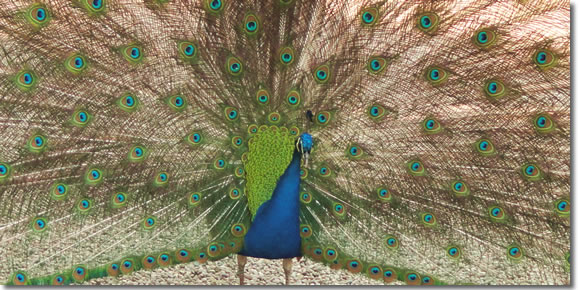
Like its sister Isola Bella, Isola Madre consists mostly of a garden-and-palazzo complex.
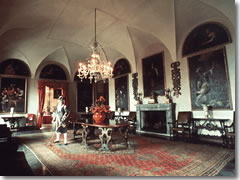
A room in the Palazzo Borromeo on Isola Madre. (Photo courtesy of Borromeo Tourism) The Villa Borromeo on Isola Madre was a summer home built largely between 1518 and 1585, and its wonderfully weird.
Unlike most palace-homes you can tour, this one actually feels a bit lived-in. The furnishings are all covered in the kind of thick, cheap plastic found protecting the living room sets of other people's elderly aunties.

The puppet stage in the Villa Borommeo on Isola Madre. (Photo courtesy of Borromeo Tourism) Portraits, paintings, and small tapestries are crowded onto the walls in total defiance of aesthetics. Mannequin servants in 18C livery and ruffled ascots stand around in odd corners with startled looks on their heavily made-up plastic faces under powdered wigs.
The collections in display are modest at best. One room holds ranks and ranks of dolls behind Plexiglas. Another is filled by a 19C marionette theater, with spare backdrops hung on the other walls, all designed by San Quirico, scenographer of Milan's La Scala opera house.
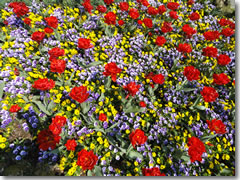 Isola Madre's real draw is the Botanical Gardens. Less formal, but far more inviting than those on Isola Bella, and more botanically interesting to boot, including the 200-year-old Kashmir Cypress, Europe's largest, weeping its Oriental needles over a gravel courtyard.
Isola Madre's real draw is the Botanical Gardens. Less formal, but far more inviting than those on Isola Bella, and more botanically interesting to boot, including the 200-year-old Kashmir Cypress, Europe's largest, weeping its Oriental needles over a gravel courtyard.
The surprisingly extensive and lush gardens surrounding the villa are filled with rare flora along with azaleas, rhododendrons, and a wall of camellias famous since the 19th century. Dry little lizards dart across the shady paths to rustle through the patches of tall-stemmed grass on either side, and the grassy lawns are strutting with exotic birds.
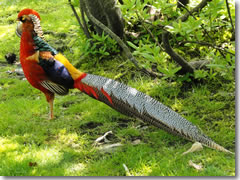 On the Piazza dei Pappagalli—or Parrot Square—the namesake parrots are mostly of the small-and-mostly-orange-and-green variety and confined to a little aviary, but all around them rare roosters, piebald pheasants, and strange species of other ground birds seemingly chosen for their overall chromatic intensity.
On the Piazza dei Pappagalli—or Parrot Square—the namesake parrots are mostly of the small-and-mostly-orange-and-green variety and confined to a little aviary, but all around them rare roosters, piebald pheasants, and strange species of other ground birds seemingly chosen for their overall chromatic intensity.
Most popular, of course, are the primadonna peacocks. I don't know if you've ever gotten a good look at a peacock, but up close they bear a suspicious resemblance to the decidedly un-exotic turkey, only with a royal blue paint job, huge tail, and mohawk of tiny round feathers on long stalks.
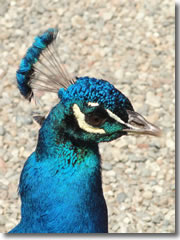 Peacocks have long been used as living lawn ornaments not only for that beautiful plumage, but also for their symbolic value.
Peacocks have long been used as living lawn ornaments not only for that beautiful plumage, but also for their symbolic value.
Originally imported from Asia (where they had their own set of symbolisms and superstitions), in medieval Europe the peacock became an icon of Christianity, the fact that it sheds its tail feathers and grows longer, prettier ones each year was taken to be a symbol of the Resurrection of Christ.
More symbolism accrued: the many eyes on its tail suggested the all-seeing eyes of God (actually, in Greek Myth they were the eyes of the monster Argus), and someone decided to float the myth that a peacock's flesh was incorruptible, further proof of the bird's divine connection.
Even outside of Christianity, those long tail feathers topped with an eyeball design have long been considered magical—whether giving the evil eye, warding it off, or functioning as a talisman of some other sort, good or evil depending on the culture, usage, and time period in question.
Isola Madre
Isole Borromeo, Stresa, Lago Maggiore
tel. +39- 0323-30-556
www.borromeoturismo.it
Open 9am–5:30pm
Open
last Sat in March–last Sun in Oct
Take a tour: If you'd prefer to take a day trip of Lake Maggiore and the Borromean Islands from Milan with an expert guide, consider booking one through our partners at Viator.com:
Hotels on the Borromean Islands
First get yourself to Stresa.
By the Stresa waterfront in the center of town is a dock where you can grab a ferry the leaves frequently, roughly every half hour in summer (tel. +39-800-551-801, www.navigazionelaghi.it).
Isola Madre is the farthest-out of the islands, a 20-min. ride (with an intermediate stop in Baveno) from Isola Superiore, which is a 5-min. ride from Isola Bella (itself a 5-min. ride from Stresa). In other words: half an hour from Stresa.
One-way ferry tickets from Stresa to Isola Madre cost €4.50 (or €3.50 from Isola Superiore, €3.80 from Isola Bella). If you're only visiting Isola Madre and Isola Bella, individual tickets are the cheapest way to go, running you €11.80 total.
If, however, you think you may also want to hop out at Isola Superiore dei Pescatori (say, for lunch), it will be cheaper to buy an unlimited ride biglietto di libera circolazione—you want it for "tratta cinque" ("zone 5"), which costs €12.20.
You can get admission to just one island (Isola Bella is €13, Isola Madre is €11), both islands together (€18), or to both islands plus the Rocca Borromeo in Angera (€21.50 for all three; €8.50 for the castle by itself).
You can get admission to just one island (Isola Bella is €13, Isola Madre is €11), both islands together (€18), or to both islands plus the Rocca Borromeo in Angera (€21.50 for all three; €8.50 for the castle by itself).
Definitely take the audioguide to learn more about the island—and grab the little pamphlet-map at the entrance kiosk to help you identify all the plants (it provides not just scientific names and such, but also interesting tidbits and facts about each).
Share this page
Search ReidsItaly.com
Isola Madre
Isole Borromeo, Stresa, Lago Maggiore
tel. +39- 0323-30-556
www.borromeoturismo.it
Open 9am–5:30pm
Open
last Sat in March–last Sun in Oct
Hotels on the Borromean Islands